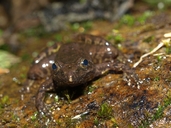|
Description
A medium-sized to rather large, brown brook-dwelling frog, 63-68 mm. Back more or less uniformly light brown to greyish; a light median band can be present. Hindlimbs more or less with dark bands.
Dorsal skin more or less smooth. Nostrils equidistant to tip of snout and to eye. Tympanum distinct, about 2/3 of eye diameter in females, 4/5 of eye diameter in males. Tibiotarsal articulation reaches at least the eye. Lateral metatarsalia separated. Hands without webbing; webbing of the foot 1(0), 2i(1), 2e(0), 3i(1), 3e(0), 4i(1.5-1), 4e(1), 5(0). Femoral glands circular in males, reduced in females. [97] Similar species: All other species of Brygoomantis are smaller. See also similar species of M. ulcerosus. Distribution and Habitat
Country distribution from AmphibiaWeb's database: Madagascar
TT Foret d'Ambohimitombo; Ankazobe [97]; Ankaratra mountains [97]. Only known from higher altitudes.Life History, Abundance, Activity, and Special Behaviors
Habits: One specimen was found on the bank of a clear brook, with stones on the bottom, in forest. In captivity the male called during day and evening, often sitting in water. [88]Call: Similar to the call of other species in the group. No recordings were made. [88]
Eggs and tadpoles: Unknown.
Comments
A member of the subgenus Brygoomantis, a group composed of small to rather large, mainly brook-dwelling frogs, 20-68 mm.
Characteristics: Lateral metatarsalia separated. Tips of fingers and toes slightly enlarged. Tibiotarsal articulation does not reach beyond tip of snout. Hands without webbing, feet webbed. Vomerine teeth are present, except in M. madecassus. Tympanum is large, more than 1/2 of eye diameter; larger in males than females.
Femoral glands more or less circular, present in males, rudimentary in females. Males with a very slightly distensible, single subgular vocal sac. Calls are not very intense. Males call from the ground near water. Eggs deposited on moist sites on the ground, close to water. Tadpoles not very specialized; tooth formula is 1/2+2//3-1/4+4//3. [97]
Species determination within this group is very difficult. The distribution data, especially those of M. ulcerosus and M. betsileanus, appear only very loosely linked to the biogeographic zonation which can be found in most Malagasy frog groups. Furthermore, evidence exists that calls differ between specimens from different localities, which can not be distinguished morphologically (see table). This indicates that the taxonomy of this group is not sufficiently clarified. Since our data do not allow a substantial contribution to such a clarification, we do not undertake any taxonomic discussion here and follow Blommers-Schlösser & Blanc (1991).
This subgenus contains: M. ulcerosus, M. betsileanus, M. curtus, M. biporus, M. alutus, M. ambohimitombi, M. madecassus. For references in the text, see here
References
Glaw, F. and Vences, M. (1994). Amphibians and Reptiles of Madagascar. M. Vences and F. Glaw Verlags GbR., Köln.
Originally submitted by: Frank Glaw and Miguel Vences (first posted 2000-11-21)
Edited by: Sunny Shah and Tate Tunstall (2003-03-04)Species Account Citation: AmphibiaWeb 2003 Mantidactylus ambohimitombi <https://amphibiaweb.org/species/4577> University of California, Berkeley, CA, USA. Accessed May 29, 2025.
Feedback or comments about this page.
Citation: AmphibiaWeb. 2025. <https://amphibiaweb.org> University of California, Berkeley, CA, USA. Accessed 29 May 2025.
AmphibiaWeb's policy on data use.
|




 Map of Life
Map of Life